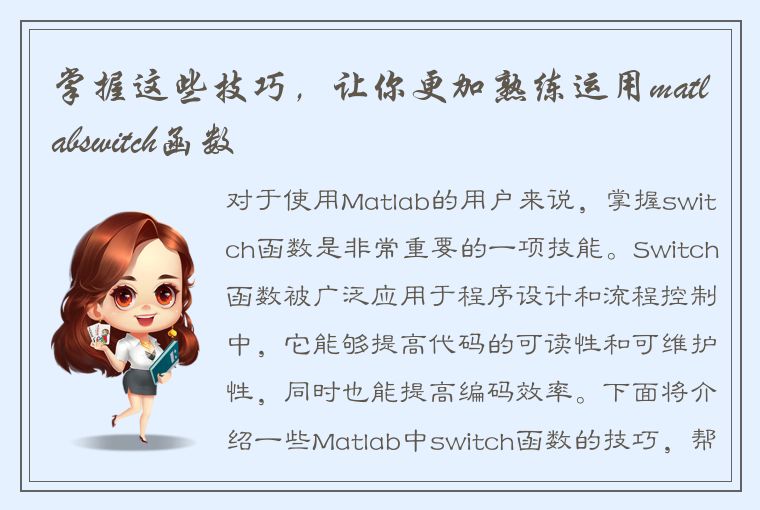对于使用Matlab的用户来说,掌握switch函数是非常重要的一项技能。Switch函数被广泛应用于程序设计和流程控制中,它能够提高代码的可读性和可维护性,同时也能提高编码效率。下面将介绍一些Matlab中switch函数的技巧,帮助读者更加熟练地运用这个函数。

1. switch语句的语法
在介绍switch函数的技巧之前,我们先来复习一下它的语法。Switch语句通常由switch关键字、case关键字、otherwise关键字和end关键字组成。具体语法如下:
switch expression
case case_expression
statements
case case_expression
statements
otherwise
statements
end
其中,expression是要测试的表达式,case_expression是需要与expression进行比较的值。
2. switch语句的使用
switch语句可以根据expression的不同值执行不同的代码块。当expression所处的值与case_expression相匹配时,就会执行当前case表达式后的语句。如果没有匹配的case_expression,则会执行otherwise后的语句。
我们可以举一个简单的例子来说明switch语句的使用,如下:
number = 3;
switch number
case 1
disp('one');
case 2
disp('two');
otherwise
disp('The number is neither one nor two.');
end
在这个例子中,number的值是3,所以执行了otherwise后的语句,输出为“The number is neither one nor two.”。
3. 使用多个case表达式
switch语句可以使用多个case表达式来匹配不同的值,并执行不同的代码块。我们可以在一个case语句中使用多个值来匹配expression,如下:
letter = 'a';
switch letter
case {'a','A'}
disp('The letter is A.');
case {'b','B'}
disp('The letter is B.');
otherwise
disp('The letter is neither A nor B.');
end
在这个例子中,对于letter的值是'a'或'A'时,输出为“The letter is A.”;对于letter的值是'b'或'B'时,输出为“The letter is B.”;对于letter的值既不是'a'也不是'b'时,输出为“The letter is neither A nor B.”。
4. 使用逗号分隔case表达式
在switch语句中,除了可以使用花括号来同时匹配多个case表达式之外,还可以使用逗号来分隔不同的表达式。例如:
grade = 85;
switch grade
case 0:49
disp('The student failed the course.');
case 50:59
disp('The student received a D.');
case 60:69
disp('The student received a C.');
case 70:79
disp('The student received a B.');
case 80:100
disp('The student received an A.');
otherwise
disp('The grade is not valid.');
end
在这个例子中,根据grade的不同值,输出相应的学生成绩。
5. 使用switch语句与向量
除了可以使用单个值来测试expression之外,我们还可以使用向量来进行测试。例如:
vector = [1,2,3,4,5,6];
for i = 1:length(vector)
switch vector(i)
case 1
disp('one');
case {2,3}
disp('two or three');
otherwise
disp('other number');
end
end
在这个例子中,我们使用一个向量来测试switch语句,输出的结果为“one、two or three、two or three、other number、other number、other number”。
6. 使用switch语句处理结构体
除了可以使用向量来测试switch语句之外,我们还可以使用结构体来进行测试。例如:
person(1).name = 'Tom';
person(1).age = 30;
person(2).name = 'Jack';
person(2).age = 32;
for i = 1:length(person)
switch person(i).name
case 'Tom'
disp('Tom is 30 years old.');
case 'Jack'
disp('Jack is 32 years old.');
otherwise
disp('The person is not in the record.');
end
end
在这个例子中,我们使用一个结构体来测试switch语句,输出的结果为“Tom is 30 years old.、Jack is 32 years old.”。
7. 使用switch语句处理cell数组
最后,我们来介绍一下如何使用switch语句处理cell数组:
cellarray = {'apple','banana','pear'};
for i = 1:length(cellarray)
switch cellarray{i}
case 'apple'
disp('This is an apple.');
case 'banana'
disp('This is a banana.');
case 'pear'
disp('This is a pear.');
otherwise
disp('Other fruit.');
end
end
在这个例子中,我们使用一个cell数组来测试switch语句,输出的结果为“This is an apple.、This is a banana.、This is a pear.”。
总结
在Matlab中,switch函数是非常重要的一项技能,它能够提高代码的可读性和可维护性,同时也能提高编码效率。本文介绍了多个关于switch函数的技巧,包括使用多个case表达式、使用逗号分隔case表达式、使用switch语句与向量/结构体/cell数组等。通过掌握这些技巧,相信读者能够更加熟练地运用Matlab中的switch函数。




 QQ客服专员
QQ客服专员 电话客服专员
电话客服专员